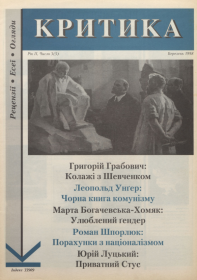Soviet album Shevchenkiana: collage, bricolage and kitsch In Krytyka, No. 3 (5), 1998, pр. 24-29.
Keywords:
Shevchenkiana, Soviet ideologySynopsis
The author examines album Shevchenkiana created by the Taras Shevchenko State Museum and analyzes the soviet interpretation of Shevchenko’s work. The article emphasizes the multifaceted nature of the poet’s personality, which makes it possible to interpret his legacy in various ways. Moreover, due to Shevchenko’s influential role in the literary and political spheres, the content and method of interpreting his work is of great importance.
Hryhorii Hrabovych identifies the following key features of the Soviet interpretation:
1) Collage. Shevchenko’s legacy is presented in album format, but it is a collage in terms of genre, as it combines textual and visual material into one whole. The collage is syncretic and all-encompassing, it interprets Shevchenko’s literary and artistic work according to templates and schemas that become the canonical interpretation.
2) Bricolage. The interpretation creates a myth of Shevchenko as a leader of the people. The album reproduces the Soviet narrative and performs an ideological function, identifying Shevchenko's image with the Ukrainian people. That is why the album constantly emphasizes the poet's peasant origin, the illustrations depict the poet among Russian elites or at a young age to present his figure as inferior and immature. The interpretation appeals to collective perception and projects Shevchenko's traits onto the entire Ukrainian people.
3) Kitsch. The canon was created in the style of socialist realism prescribed by the party, it primitivizes and brutalizes Shevchenko's work, and reveals a systemic anti-aestheticism.
Downloads




